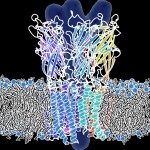Link to Pubmed [PMID] – 24836522
Link to HAL – Click here
Link to DOI – 10.1016/j.bbagen.2014.05.007
Biochim. Biophys. Acta 2015 Mar;1850(3):511-23
BACKGROUND: Pentameric ligand-gated ion channels (pLGICs) mediate fast chemical transmission of nerve signals in the central and peripheral nervous system. On the functional side, these molecules respond to the binding of a neurotransmitter (glycine, GABA, acetylcholine or 5HT3) in the extracellular domain (ECD) by opening their ionotropic pore in the transmembrane domain (TMD). The response to the neurotransmitter binding can be modulated by several chemical compounds acting at topographically distinct sites, as documented by a large body of literature. Notably, these receptors are the target of several classes of world-wide prescribed drugs, including general anesthetics, smoking cessation aids, anxiolytics, anticonvulsants, muscle relaxants, hypnotics and anti-emetics. On the structural side recent progress has been made on the crystallization of pLGICs in its different allosteric states, especially pLGICs of bacterial origin. Therefore, structure-function relationships can now be discussed at the atomic level for pLGICs.
SCOPE OF REVIEW: This review focuses on the crystallographic structure of complexes of pLGICs with a number of ligands of pharmacological interest. First, we review structural data on two key functional aspects of these receptors: the agonist-induced activation and ion transport itself. The molecular understanding of both these functional aspects is important, as they are those that most pharmacological compounds target. Next, we describe modulation sites that have recently been documented by X-ray crystallography. Finally, we propose a simple geometric classification of all these pharmacological sites in pLGICs, based on icosahedrons.
MAJOR CONCLUSIONS: This review illustrates the wealth of structural insight gained by comparing all available structures of members of the pLGIC family to rationalize the pharmacology of structurally diverse drugs acting at topographically distinct sites. It will be highlighted how sites that had been described earlier using biochemical techniques can be rationalized using structural data. Surprisingly, the use of icosahedral symmetry allows to link together several modulation sites, in a way that was totally unanticipated.
GENERAL SIGNIFICANCE: Overall, understanding the interplay between the different modulation sites at the structural level should help the design of future drugs targeting pLGICs. This article is part of a Special Issue entitled structural biochemistry and biophysics of membrane proteins.


